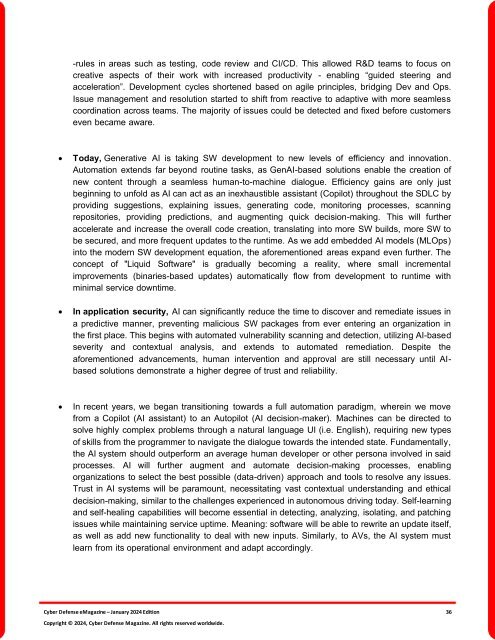The Cyber Defense eMagazine January Edition for 2024
Cyber Defense eMagazine January Edition for 2024 #CDM #CYBERDEFENSEMAG @CyberDefenseMag by @Miliefsky a world-renowned cyber security expert and the Publisher of Cyber Defense Magazine as part of the Cyber Defense Media Group as well as Yan Ross, Editor-in-Chief and many more writers, partners and supporters who make this an awesome publication! 201 page January Edition fully packed with some of our best content. Thank you all and to our readers! OSINT ROCKS! #CDM #CDMG #OSINT #CYBERSECURITY #INFOSEC #BEST #PRACTICES #TIPS #TECHNIQUES
Cyber Defense eMagazine January Edition for 2024 #CDM #CYBERDEFENSEMAG @CyberDefenseMag by @Miliefsky a world-renowned cyber security expert and the Publisher of Cyber Defense Magazine as part of the Cyber Defense Media Group as well as Yan Ross, Editor-in-Chief and many more writers, partners and supporters who make this an awesome publication! 201 page January Edition fully packed with some of our best content. Thank you all and to our readers! OSINT ROCKS! #CDM #CDMG #OSINT #CYBERSECURITY #INFOSEC #BEST #PRACTICES #TIPS #TECHNIQUES
You also want an ePaper? Increase the reach of your titles
YUMPU automatically turns print PDFs into web optimized ePapers that Google loves.
-rules in areas such as testing, code review and CI/CD. This allowed R&D teams to focus on<br />
creative aspects of their work with increased productivity - enabling “guided steering and<br />
acceleration”. Development cycles shortened based on agile principles, bridging Dev and Ops.<br />
Issue management and resolution started to shift from reactive to adaptive with more seamless<br />
coordination across teams. <strong>The</strong> majority of issues could be detected and fixed be<strong>for</strong>e customers<br />
even became aware.<br />
• Today, Generative AI is taking SW development to new levels of efficiency and innovation.<br />
Automation extends far beyond routine tasks, as GenAI-based solutions enable the creation of<br />
new content through a seamless human-to-machine dialogue. Efficiency gains are only just<br />
beginning to unfold as AI can act as an inexhaustible assistant (Copilot) throughout the SDLC by<br />
providing suggestions, explaining issues, generating code, monitoring processes, scanning<br />
repositories, providing predictions, and augmenting quick decision-making. This will further<br />
accelerate and increase the overall code creation, translating into more SW builds, more SW to<br />
be secured, and more frequent updates to the runtime. As we add embedded AI models (MLOps)<br />
into the modern SW development equation, the a<strong>for</strong>ementioned areas expand even further. <strong>The</strong><br />
concept of "Liquid Software" is gradually becoming a reality, where small incremental<br />
improvements (binaries-based updates) automatically flow from development to runtime with<br />
minimal service downtime.<br />
• In application security, AI can significantly reduce the time to discover and remediate issues in<br />
a predictive manner, preventing malicious SW packages from ever entering an organization in<br />
the first place. This begins with automated vulnerability scanning and detection, utilizing AI-based<br />
severity and contextual analysis, and extends to automated remediation. Despite the<br />
a<strong>for</strong>ementioned advancements, human intervention and approval are still necessary until AIbased<br />
solutions demonstrate a higher degree of trust and reliability.<br />
• In recent years, we began transitioning towards a full automation paradigm, wherein we move<br />
from a Copilot (AI assistant) to an Autopilot (AI decision-maker). Machines can be directed to<br />
solve highly complex problems through a natural language UI (i.e. English), requiring new types<br />
of skills from the programmer to navigate the dialogue towards the intended state. Fundamentally,<br />
the AI system should outper<strong>for</strong>m an average human developer or other persona involved in said<br />
processes. AI will further augment and automate decision-making processes, enabling<br />
organizations to select the best possible (data-driven) approach and tools to resolve any issues.<br />
Trust in AI systems will be paramount, necessitating vast contextual understanding and ethical<br />
decision-making, similar to the challenges experienced in autonomous driving today. Self-learning<br />
and self-healing capabilities will become essential in detecting, analyzing, isolating, and patching<br />
issues while maintaining service uptime. Meaning: software will be able to rewrite an update itself,<br />
as well as add new functionality to deal with new inputs. Similarly, to AVs, the AI system must<br />
learn from its operational environment and adapt accordingly.<br />
<strong>Cyber</strong> <strong>Defense</strong> <strong>eMagazine</strong> – <strong>January</strong> <strong>2024</strong> <strong>Edition</strong> 36<br />
Copyright © <strong>2024</strong>, <strong>Cyber</strong> <strong>Defense</strong> Magazine. All rights reserved worldwide.

















